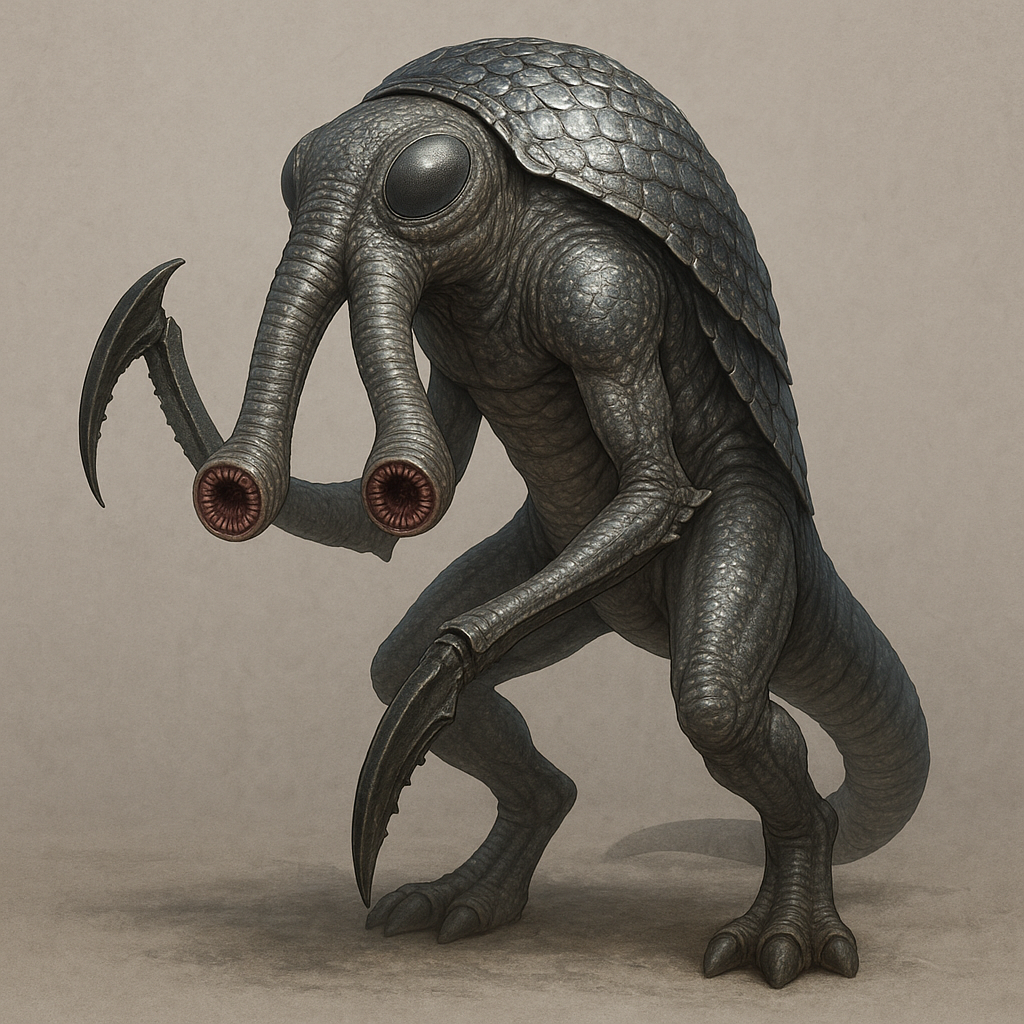Bogler
“The problem isn’t studying
Bogler anatomy—it’s that the Astro-Landing Force never leaves us anything intact. I’ve made three requests for dissection specimens and received three crates of minced meat. It’s tragic. They’re fascinating creatures.”
Biology and Physiology
The Boglers are a semi-upright species native to the cratered super-Earth known as Vaskol, orbiting the energetic star Eta Corvi. Their physiology is a brutal testament to evolutionary pressure in one of the most hostile environments known to xenobiology. Built for survival, their bodies combine predation and resilience in ways that baffle even experienced exobiologists. Boglers move on four limbs for speed, but can raise the front of their bodies to assume an intimidating, bipedal stance for combat or mating. Their rear limbs are thick, padded, and well-suited for both stealth and stability in high gravity, while the forelimbs end in multi-jointed “probes” equipped with vibrating claws. These claws produce high-frequency chirrups and slice through metal and armor alike, acting as natural ultrasonic cutters.
Their heads feature two wide, unmoving UV-sensitive eyes that give them precise vision in their home planet’s radiation-heavy environment. Most striking are their twin prehensile trunks—segmented appendages resembling those of an elephant, each tipped with a gustatory orifice ringed by razor teeth. These trunks are simultaneously sensory organs, manipulators, and feeding tools, and they serve a central role in both combat and reproduction. Their hearing is divided among Helmholtz-like resonance chambers located at the base of each trunk, allowing them to detect directional sound within narrow but high-decibel ranges. Touch is handled through nerve filaments distributed across their dermal layers and scale surfaces, providing sensitivity to both temperature and tactile stimuli.
The Bogler dermal system is comprised of several formidable layers. A thick subcutaneous fat layer grants resistance to extreme temperature swings, while a fibrous lattice of collagen knots offers blunt and piercing trauma Protection. Above that, a mucus-secreting epidermis houses toxic, semi-sentient immune cells capable of attacking foreign organic matter—an evolutionary defense system functioning like aggressive, externalized leukocytes. These same cells, during mating cycles, fuse when exposed to compatible dermal hormones, forming reproductive buds. Their outermost layer consists of reflective, scale-like plates made of magnesium-silica chitin. These flexible, transparent structures reflect UV and even laser light, giving Boglers passive Protection against energy weapons and environmental radiation. When triggered, the scales can contract to focus light, releasing a weak but effective directed laser beam—a rare example of biologically induced photonic aggression.
Evolution and Reproduction
Boglers evolved in isolated oases under vast metallic overhangs on Vaskol, a world ravaged twice annually by biotoxic dust storms and micro-asteroid barrages. These evolutionary crucibles favored aggressive, opportunistic predators, and the Boglers rose from the dominant carnivores of the planet's largest oasis. Their development was accelerated by a brief but intense industrial period sparked by their discovery of a magnesium silicide reaction that produced silane gas. This discovery led to combustion engines and weaponry akin to early 20th-century human warfare.
Bogler reproduction is as alien as it is violent. Hermaphroditic and semi-asexual, two Boglers in reproductive sync engage in ritualized combat, exchanging hormonal injections via nematocyst-lined scales. The “loser” of this clash is impregnated via dermal mucus fusion and sprouts between ten and twenty finger-sized buds. These are eventually shed and guarded until maturity. Bogler society does not protect offspring communally—each bud is a potential target for predation, even from unrelated Boglers, necessitating fierce maternal Protection.
This complex hormonal system is tied directly to Vaskol’s magnetic and seasonal rhythms. When taken offworld, Boglers often suffer from Budding Cycle Dysregulation, an autonomic condition where hormonal triggers misfire, causing violent mating fugues under stress, negotiation, or exposure to unfamiliar EM fields. Combined with their evolved Predator Reflex Syndrome—an involuntary, often lethal response to sudden stimuli—these behavioral traits make Boglers difficult to manage in diplomatic or civilian contexts.
Technology and Reticulan Influence
Bogler spaceflight and modern warfare technology are not their own invention. Near the end of their industrial revolution, a Reticulan saucer crashed into Vaskol during a dust storm and was captured intact. The Boglers—already adept at reverse engineering and familiar with scavenging—dissected the ship and began replicating its technology, bolt by bolt, without ever fully understanding it. This includes paraspace skimming drives and Stellar-Bonded Wormhole traversal, which they use for interstellar raids.
Boglers lack a foundational grasp of electrical theory, quantum mechanics, or subspace physics. Instead, they treat high technology as a form of inherited machinery. Their ships are patchwork but effective, outfitted with retrofitted Reticulan tools and salvaged gear from successful raids. Due to their reflective biology, they never developed lasers themselves—projectile weapons remain their norm. Their power systems are finicky and poorly maintained, and large-scale energy production is rarely sustainable. Still, they are inventive looters, having co-opted everything from Cygnan memory-plastics to Terran vacuum suits in combat scenarios.
A typical Bogler raid begins with a barrage of asteroids channeled through a Stellar-Bond Wormhole. Bogler vessels slip through amidst the debris, causing confusion and planetary chaos. Amidst this smokescreen, they target civilian convoys or small military outposts, plundering what they can before vanishing through paraspace-laced escape routes. When pursued, they plant Reticulan paraspace mines to cover their retreat—mines that are undetectable but open small paraspace traps that can shunt ships full on parsecs in random directions.
Behavioral Quirks and Offworld Limitations
Boglers suffer from several traits that become increasingly maladaptive in offworld environments. Their Mirrorflash Seizure Response, a product of their quantum time-sense and reflective skin, can cause full sensory overload and seizures in cities, Starships, or hyperspace transit. Their RAI Detection Blindness is particularly dangerous—while their time-sense allows them to predict kinetic outcomes, it misreads or entirely ignores the presence of Redspace Adversarial Intelligences. As a result, they are easy prey for memetic infiltration and possession.
Socially, Boglers resent being treated as a nuisance rather than a threat. While species without militaries—such as the Reticulans or Cygnans—fear them intensely, more militarized civilizations (like the ALF) tend to dismiss them as glorified space raiders. This has bred deep cultural anger and humiliation among Boglers, who crave recognition of their predatory prowess. The ALF nickname “Bogler” (derived from their dual-trunk battlecry of Bog! / Glurb!) only deepens the insult.
Despite their flaws, Boglers are a true evolutionary success story—rising from scattered desert oases to interstellar piracy in under 31,000 generations. Their adaptability, brutal efficiency, and fearless aggression make them one of the most intriguing and dangerous young species in known space.









Comments